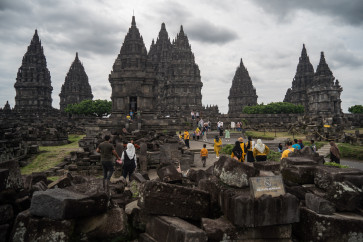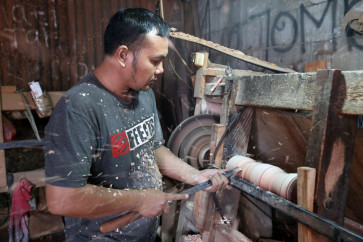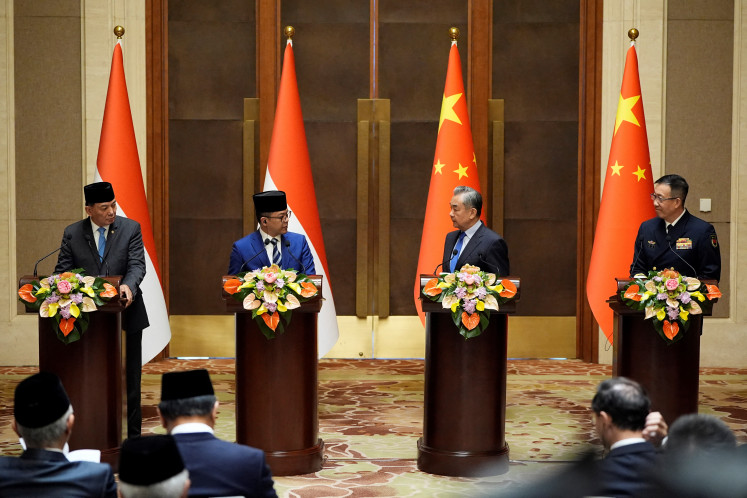From animal hunter to animal rescuer
Hi there!: An East Javan langur sits inside a cage at the Javan Langur Center in Batu, East Java
Change text size
Gift Premium Articles
to Anyone

Hi there!: An East Javan langur sits inside a cage at the Javan Langur Center in Batu, East Java.
It was never going to end well for at least one of the party of four young men, three rifles and a single monkey. At least, so the hunters thought.
After the animal had been hit by about 20 rounds, it seemed dead, but it was stuck in the top branches of a tree. Syamsul was the sharpest shot and might have joined the army to kill other primates of his own species had he not had to wear glasses.
So, the bravest of the gallant woodsmen shinnied up the tree to retrieve the cadaver for a meal. Then, Syamsul made a discovery that was to change his life.
The monkey had been executed for the crime of being simian, but her baby was still clinging to its mother’s breast and life. Shots had grazed its leg and face, but done no lasting harm.
Syamsul took the little creature home and discovered compassion. He nursed it back to health and eventually gave it to a friend whose son wanted a pet. He started thinking about the way he was behaving and his relationship with the natural world.
Syamsul no longer prowls the dense bush that cascades from his three-level home in a kampong, flanking the Brantas River in Malang. When he hears men scouring the undergrowth with dogs and weapons he whistles to distract the pursuit.
He used to rain stones from a catapult onto the stalkers until dissuaded by his wife Suli who said he was being too aggressive. It was certainly not appropriate behavior for the Buddhist convert and animal protector he has become since his monkey moment decades earlier.
Syamsul is now an active member of an animal rescue and release field camp called the Javan Langur Center in Batu, East Java. There he helps in the rehabilitation of langurs, which are often caged as pets.
He wants to encourage more care for the natural world, but knows changing social behavior takes time and effort. The days of the Soeharto era when meek communities obeyed government orders have gone. Instead, he’s trying to alter by example.
This means using his talents as a musician and dalang (puppet master) to promote conservation under the stage name Kardjo.
Syamsul has also mastered the art of wayang suket (grass puppets) using dried fimbry to weave the tiny figures. He uses this skill to emphasize the interconnectedness of nature and humanity through his adventure stories involving animals.
One of the stories is about his first job relocating a crocodile and learning how to be wary of wildlife. A colleague was badly kicked by a supposedly tame cassowary brought from West Papua by a returning soldier who found the bird too big to handle in suburbia.
It seemed docile — until the rescuers arrived; their intentions were good, but not their planning.
“Returning animals to the wild has to be handled carefully,” Syamsul said while watching field camp workers feed fresh-cut branches of acacia to langurs living in a cluster of tall wire cages. “Those born in captivity or captured young have lost foraging and survival skills. This is why we keep visitors away. The langurs need to discover distrust. They look ferocious when they make threatening faces, but flee when that tactic fails.”

Despite being in a heavily used holiday area in central East Java, only the curious will discover the camp. It is tucked away from the food stalls and sports grounds at the Coban Talun recreational park, set 1,350 meters up in the cool and rugged mountains around Batu.
The camp is funded by the Aspinall Foundation, an international conservation charity that works in some of the world’s most fragile environments to save endangered animals and return them to the wild.
John Aspinall, an eccentric British zoo owner and entrepreneur who made (and lost) fortunes though gambling, created the foundation in 1984. He died in 2000.
The foundation has camps in Bandung and East Java. Last year, 15 langurs were imported from zoos in Britain and France for return to the wild in East Java.
The field camp’s facilities include incubators, scales and a medicine cabinet. The buildings are basic with dirt floors and bamboo walls, but they include a small library.
The workshop lists details of the seven males and 14 females going through the stages of acclimatisation. Rinda and Mira, Moses and Oat feature on a whiteboard, but the volunteers, on the roster to camp overnight as observers and security guards, try to avoid using names in their daily dealings.
“It makes the task so much harder if we develop emotional attachments,” said Syamsul.
“Our job is to ensure they can survive without our help. We wear masks and gloves and clean cages twice daily to avoid disease transmission.”
Leaf-eating langurs, frequently mistaken for monkeys, have tails that are often close to a meter long and twice their body length. Most have black fur, but a few of the East Javan variety are orange.
Langurs live in groups of five or six lorded over by a dominant male. Those that have spent years in cages alone do not know how to relate to others.
Watching how a langur interacts with other langurs is critical prior to release, which may come months after the animal is brought to the camp.
So far, more than 50 langurs, plus other creatures like the nocturnal loris, have been released. Although the center has access to only 4 hectares of forest leased from the government, the langurs should be safe in the 100-ha park where indigenous creatures are protected.
Apart from their attraction as pets, monkeys and langurs have been hunted because locals believe that their meat can be used as an aphrodisiac and cures skin diseases. Although not grounded on scientific fact, this belief persists.
East Javan langurs are now an endangered species with probably less than 3,000 in the wild. As their numbers fall, values rise. The illegal wildlife trade in Indonesia is now worth Rp 13 trillion (US$975 million) a year, according to the Wildlife Conservation Society.
Syamsul dedicates his work with the langurs at the camp to his late mother, Sutrisnowati, who died of cancer in her early 50s.
“I was very close to my mom,” he said.
“She was a wise person steeped in Javanese lore who taught me how to appreciate and honor our culture and people. I’d dropped out of high school and just wandered around. When she died and left me the house I set out to repair the damage I’d done.”
— Photos by Erlinawati Graham









